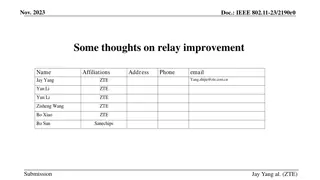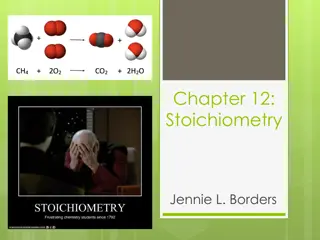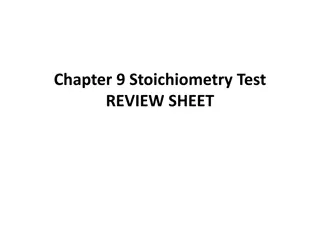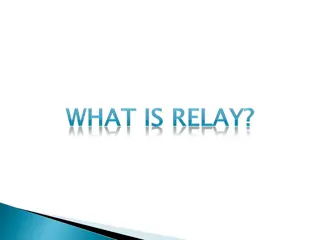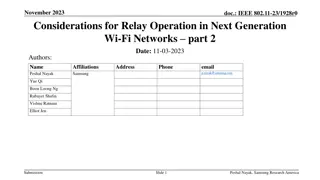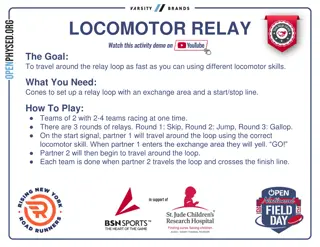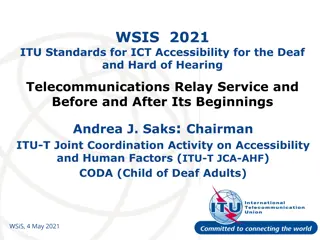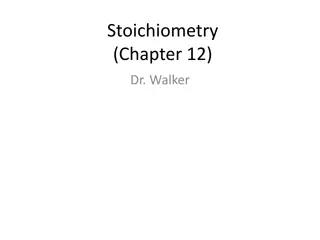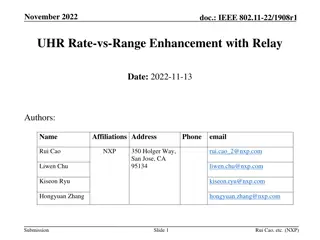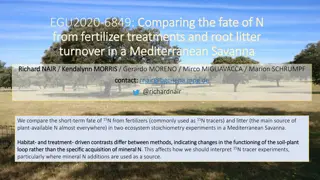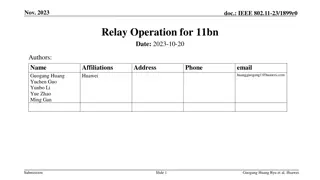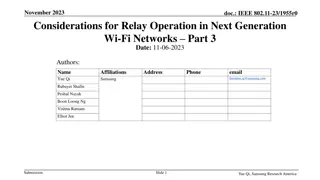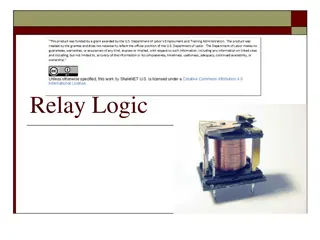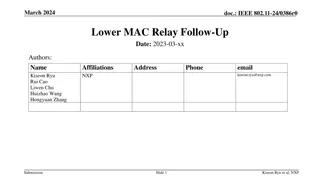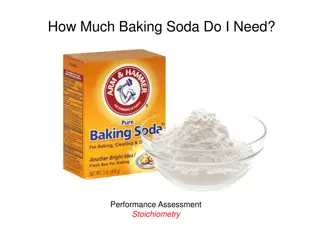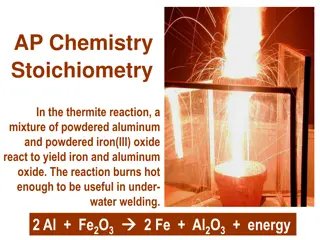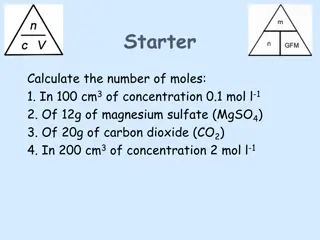STOICHIOMETRY BOARD RELAY
In this stoichiometry board relay activity, players set up problems, work through conversion factors, predict reaction products, calculate moles of products formed, and determine the mass of resulting compounds. Using reactions involving sodium carbonate, barium nitrate, barium carbonate, and sodium nitrate, students practice stoichiometry concepts in a collaborative setting.
Download Presentation

Please find below an Image/Link to download the presentation.
The content on the website is provided AS IS for your information and personal use only. It may not be sold, licensed, or shared on other websites without obtaining consent from the author.If you encounter any issues during the download, it is possible that the publisher has removed the file from their server.
You are allowed to download the files provided on this website for personal or commercial use, subject to the condition that they are used lawfully. All files are the property of their respective owners.
The content on the website is provided AS IS for your information and personal use only. It may not be sold, licensed, or shared on other websites without obtaining consent from the author.
E N D
Presentation Transcript
STOICHIOMETRY BOARD RELAY
ROLES: Player 1: set up problem and work through first conversion factor Player 2: work through second conversion factor (if there is one) Player 3: work through third conversion factor (if there is one) Player 4: check work and solve If there is no 4thperson in your group, All students will check work and solve.
WRITE AND BALANCE THE FOLLOWING REACTION: Solutions of sodium carbonate and barium nitrate react. Predict the products.
Solutions of sodium carbonate and barium nitrate react. Predict the products. 1 Na2CO3+ 1 Ba(NO3)2 1 BaCO3+ 2 NaNO3
Given 0.50 moles of barium nitrate, how many moles of sodium nitrate are formed?
Given 0.50 moles of barium nitrate, how many moles of sodium nitrate are formed? 1 Na2CO3 + 1 Ba(NO3)2 1 BaCO3 + 2 NaNO3 0.50 mol Ba(NO3)22 mol NaNO3 = 1 mole NaNO3 1 mol Ba(NO3)2
What mass of barium carbonate will form if 25.0g of sodium carbonate reacts with excess barium nitrate?
What mass of barium carbonate will form if 25.0g of sodium carbonate reacts with excess barium nitrate? 1 Na2CO3 + 1 Ba(NO3)2 1 BaCO3 + 2 NaNO3 25.0g Na2CO3 1 mole Na2CO31 mol BaCO3 197.3g BaCO3 106g Na2CO31 mol Na2CO3 1mol BaCO3 = 46.5g BaCO3
What mass of sodium nitrate will form if 3.2 x 1024 formula units barium nitrate reacts with excess sodium carbonate?
What mass of sodium nitrate will form if 3.2 x 1024 formula units barium nitrate reacts with excess sodium carbonate? 1 Na2CO3 + 1 Ba(NO3)2 1 BaCO3 + 2 NaNO3 3.2 x 1024 f.u. Ba(NO3)2 1 mole Ba(NO3)2 6.02 x 1023 f.u. Ba(NO3)21 mol Ba(NO3)2 1mol 2 mol NaNO3 85g = 903.7g NaNO3
WRITEANDBALANCETHEFOLLOWING REACTION: Lithium and nitrogen gas react. Predict the products.
Lithium and nitrogen gas react. Predict the products. 6 Li + 1 N2 2 Li3N
What mass of lithium is needed to react with 15.0g of nitrogen?
What mass of lithium is needed to react with 15.0g of nitrogen? 6 Li + 1 N2 2 Li3N 15.0g N2 1 mol N2 28.0g N2 6 mol Li 1 mol N2 6.9g Li 1 mol Li = 22.2g Li
What mass of lithium is needed to form 12.2g of lithium nitride?
What mass of lithium is needed to form 12.2g of lithium nitride? 6 Li + 1 N2 2 Li3N 12.2g Li3N 1 mol Li3N 6 mol Li 34.7g Li3N 2 mol Li3N 1 mol Li 6.9g Li = 7.3g Li
How many atoms of Lithium react with 2.8 x 1022 molecules of nitrogen?
How many atoms of Lithium react with 2.8 x 1022 molecules of nitrogen? 6 Li + 1 N2 2 Li3N 2.8 x 1022 m/c N2 1 mol N26 mol Li 6.02 x 1023 at Li 6.02 x 1023 m/c N21 mol N2 1 mol Li = 4.7 x 1021 atoms Li
WRITEANDBALANCETHEFOLLOWING REACTION: Solutions of magnesium sulfate and aluminum nitrate are mixed. Predict the products.
Solutions of magnesium sulfate and aluminum nitrate are mixed. Predict the products. 3 MgSO4+ 2 Al(NO3)3 3 Mg(NO3)2 + 1 Al2(SO4)3
How many grams of magnesium sulfate are needed to react with 0.75 moles of aluminum nitrate?
How many grams of magnesium sulfate are needed to react with 0.75 moles of aluminum nitrate? 3 MgSO4+ 2 Al(NO3)3 3 Mg(NO3)2 + 1 Al2(SO4)3 0.75 mol Al(NO3)3 3 moles MgSO4 120.4g MgSO4 2 moles Al(NO3)3 1 mol MgSO4 = 135.5g MgSO4
What mass of aluminum sulfate will form if 12.0g of aluminum nitrate react with 20.5g of magnesium sulfate? Identify the limiting reactant and excess reactant.
What mass of aluminum sulfate will form if 12.0g of aluminum nitrate react with 20.5g of magnesium sulfate? Identify the limiting reactant and excess reactant. 3 MgSO4+ 2 Al(NO3)3 3 Mg(NO3)2 + 1 Al2(SO4)3 12.0g Al(NO3)3 1 mol Al(NO3)3 1 mol Al2(SO4)3 342.3g Al2(SO4)3 213.0g Al(NO3)3 2 mol Al(NO3)3 1 mol Al2(SO4)3 = 9.6g Al2(SO4)3 20.5g MgSO4 1 mol MgSO41 mol Al2(SO4)3 342.3g Al2(SO4)3 120.4g MgSO4 3 mol MgSO4 1 mol Al2(SO4)3 = 19.4g Al2(SO4)3 L.R. = Al(NO3)3 E.R. = MgSO4
WRITEANDBALANCETHEFOLLOWING REACTION: Write and balance the equation for the combustion of dicarbon dihydride.
Write and balance the equation for the combustion of dicarbon dihydride. 2 C2H2 + 5 O2 4 CO2 + 2 H2O
How many moles of water will be produced if 3.8 moles of oxygen react with excess dicarbon dihydride?
How many moles of water will be produced if 3.8 moles of oxygen react with excess dicarbon dihydride? 2 C2H2 + 5 O2 4 CO2 + 2 H2O 3.8 mol O2 2 moles H2O 5 moles O2 = 1.5 moles H2O
How many molecules of carbon dioxide will be produced if 0.85 moles of water are produced?
How many molecules of carbon dioxide will be produced if 0.85 moles of water are produced? 2 C2H2 + 5 O2 4 CO2 + 2 H2O 0.85 mol H2O4 moles CO2 6.02 x 1023 m/c CO2 2 moles O2 1 mol CO2 = 1.0 x 1024 m/c CO2
If 5.8 grams of dicarbon dihydride react with 4.2 grams of oxygen gas, how many grams of water will be produced? Identify the limiting reactant and what is the excess reactant.
If 5.8 grams of dicarbon dihydride react with 4.2 grams of oxygen gas, how many grams of water will be produced? Identify the limiting reactant and what is the excess reactant. 2 C2H2 + 5 O2 4 CO2 + 2 H2O 5.8g C2H2 1 mole C2H2 2 moles H2O 18.0 g H2O 26.0g C2H2 2 moles C2H2 1 mole H2O = 4.0g H2O 4.2g O2 1 mole O2 2 moles H2O 18.0 g H2O 32.0g O2 5 moles O2 1 mole H2O = 0.9 g H2O L.R. = O2 E.R. = C2H2


